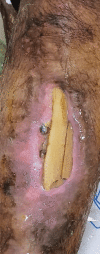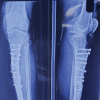How Not To Fix a Tibial Fracture: A Case Report on Treatment By a Quack
- PMID: 37435249
- PMCID: PMC10331172
- DOI: 10.7759/cureus.40203
How Not To Fix a Tibial Fracture: A Case Report on Treatment By a Quack
Abstract
Quackery in the orthopaedic profession has existed for quite a long time. Due to the shortage of orthopaedic healthcare staff in public hospitals and the high costs in private facilities, members of disadvantaged communities turn to unlicensed and unskilled practitioners (quacks). The main factors responsible for the increased number of quacks performing orthopaedic treatment are illiteracy, high treatment cost, mismatch in the orthopaedic surgeon-to-population ratio, especially in rural areas, and the absence of any form of health insurance. Moreover, their easy availability and offer of low-cost treatment draw innocent and illiterate patients to them, even though these quacks perform orthopaedic treatment in the most unhygienic, unsterilized, and unconventional manner. The government should intervene and take measures to make orthopaedic treatment more affordable and accessible, especially to the rural population.
Keywords: infections; mismanagement; non-union; quack; tbs (traditional bone setter).
Copyright © 2023, Singh et al.
Conflict of interest statement
The authors have declared that no competing interests exist.
Figures




Similar articles
-
Some empirical observations on the correlates of quackery propensity in Sindh's populace.J Pak Med Assoc. 2023 Sep;73(9):1887-1890. doi: 10.47391/JPMA.8053. J Pak Med Assoc. 2023. PMID: 37817705
-
Factors contributing to the public proneness towards quacks in Sindh.Pan Afr Med J. 2020 Oct 21;37:174. doi: 10.11604/pamj.2020.37.174.23411. eCollection 2020. Pan Afr Med J. 2020. PMID: 33447329 Free PMC article.
-
Perceptions and use of dental quacks (unqualified dental practitioners) and self rated oral health in Trinidad.Int Dent J. 2003 Dec;53(6):447-54. doi: 10.1002/j.1875-595x.2003.tb00886.x. Int Dent J. 2003. PMID: 14725372
-
Prostate cancer disparities in South Carolina: early detection, special programs, and descriptive epidemiology.J S C Med Assoc. 2006 Aug;102(7):241-9. J S C Med Assoc. 2006. PMID: 17319238 Review.
-
[Definition of 'quack' in the public debate on alternative medicine].Ned Tijdschr Geneeskd. 2001 Jan 20;145(3):141-2. Ned Tijdschr Geneeskd. 2001. PMID: 11206127 Review. Dutch.
Cited by
-
Intersectoral Collaboration Between Traditional Bonesetters and Formal Healthcare: A Systematic Review on Past Initiatives and Stakeholder Perspectives.World J Surg. 2025 Mar;49(3):652-663. doi: 10.1002/wjs.12503. Epub 2025 Feb 6. World J Surg. 2025. PMID: 39916315 Free PMC article.
References
-
- Evaluation of problems related to malpractice and professionalism in Islamabad area-a study. Khan AS, Syed AY, Qureshi AM, Ijaz SH, Khan AA. https://pesquisa.bvsalud.org/portal/resource/pt/emr-174418 Pak Oral Dental J. 2004;24:74–76.
-
- Performance of a trained traditional bonesetter in primary fracture care. Onuminya JE. https://journals.co.za/doi/abs/10.10520/EJC68703. South African Medical Journal. 20061;96:320–322. - PubMed
-
- Complications of fracture treatment by traditional bonesetters in southwest Nigeria. OlaOlorun DA, Oladiran IO, Adeniran A. Fam Pract. 2001;18:635–637. - PubMed
-
- Treatment by quacks still an issue of concern. Zameer A, Vakil SM, Bhat TA, Dhar SA, Khurshid L, Sofi AH. https://www.longdom.org/open-access/treatment-by-quacks-still-an-issue-o... Orthop Muscular Syst. 2016;5:120.
-
- The strengths and weaknesses of Turkish bone-setters. Hatipoğlu S, Tatar K. https://pubmed.ncbi.nlm.nih.gov/7794467/ World Health Forum. 1995;16:203–205. - PubMed
Publication types
LinkOut - more resources
Full Text Sources
